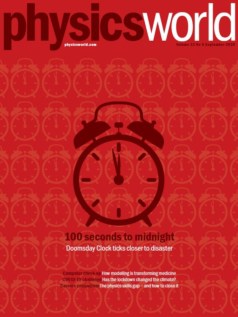The September 2020 issue of Physics World has a COVID-19 and Doomsday theme running through it

Life has been turned upside-down since COVID-19 gripped the world earlier this year. I wonder, though, what members of the Bulletin of the Atomic Scientists will make of the pandemic.
Every year they meet to decide the time on the Doomsday Clock – a notional device created by physicists shortly after the Second World War to surmise how close the world is to destruction. In January the clock was set at 100 seconds to midnight – the furthest forward it’s ever been.
In the new issue of Physics World magazine, Rachel Brazil describes how the clock gets set, which these days is no longer based solely on the risk from nuclear conflict, but also takes into account climate change, cyber security and biosecurity risks – including pandemics. My bet is on Bulletin staff edging the clock even further towards midnight
Elsewhere in the new issue, Sam Vennin shows how scientific modelling is increasingly critical to many aspects of medicine, including the spread of viruses, while Kate Ravilious finds out how lockdown and travel restrictions have led to air pollution plummeting, giving atmospheric scientists a unique and unexpected opportunity to study its impact on the weather and climate.
If you’re a member of the Institute of Physics, you can read the whole of Physics World magazine every month via our digital apps for iOS, Android and Web browsers. Let us know what you think about the issue on Twitter, Facebook or by e-mailing us at pwld@ioppublishing.org.
For the record, here’s a rundown of what else is in the issue.
• Tunnelling measured with ultracold atoms – Researchers have determined the time taken for an atom to tunnel through a laser beam, which could have implications for quantum technologies, as Philip Ball reports
• Trio of probes launch to Mars – China, the UAE and the US have sent craft to Mars to study the planet in greater detail, with NASA set to conduct the first controlled flight on another planet, as Ling Xin, Michael Banks and Liz Kruesi report
• A quantum revolution – Chaoyang Lu from the University of Science and Technology of China in Hefei talks to Michael Banks about planning Quantum 2020 – a major online conference – and the future of quantum technologies
• Hacking a path to innovation – Bonnie Tsim says “hackathons” are a great way for scientists to apply their skills to the commercial world
• First-hand insights – With so much spin, jargon and fake news, it can be hard to know what businesses are really up to. James McKenzie finds that hearing a company’s vision first hand is key to understanding its potential
• It’s a material world – From wine and skis to clocks and bone implants, Linn Hobbs has a passion for everyday materials, as he tells Robert P Crease
• 100 seconds to midnight – For almost 75 years, the Doomsday Clock has monitored how close humankind is to global catastrophe. With the clock now closer to midnight than ever before, Rachel Brazil talks to physicists who say we must step up our efforts to prevent disaster
• Has the COVID-19 lockdown changed Earth’s climate? – The lockdown measures imposed by many nations due to the COVID-19 pandemic have led to air pollution falling dramatically, thereby offering scientists a rare opportunity to study its links with climate and weather. But as Kate Ravillious discovers, it’s a complicated connection
• How modelling is transforming medicine – Computational modelling has been brought under the spotlight during the COVID-19 pandemic, with scientists trying to predict how the SARS-CoV-2 virus will spread. But epidemiology is not the only medical field in which modelling is sparking breakthroughs, as Sam Vennin explains

Physics and cars: the August 2020 issue of Physics World is now out
• Build a bot – Ian Randall reviews How to Grow a Robot: Developing Human-Friendly, Social AI by Mark Lee
• Beyond the bounds of Earth – Andrew Glester reviews the film Proxima and interviews its screenwriter-director Alice Winocour
• Closing the skills gap – Why do many science graduates lack the skills that industry is looking for? Sean Ryan and Veronica Benson of the South-East Physics Network explore the problem and discover that there is one straightforward way for universities and businesses to address this
• Ask me anything – Nanophysicist Deji Akinwande from the University of Texas at Austin gives his tips for a rewarding career in physics
• Lattice layabout in the park – Hamish Johnston muses on social distancing in public spaces.



